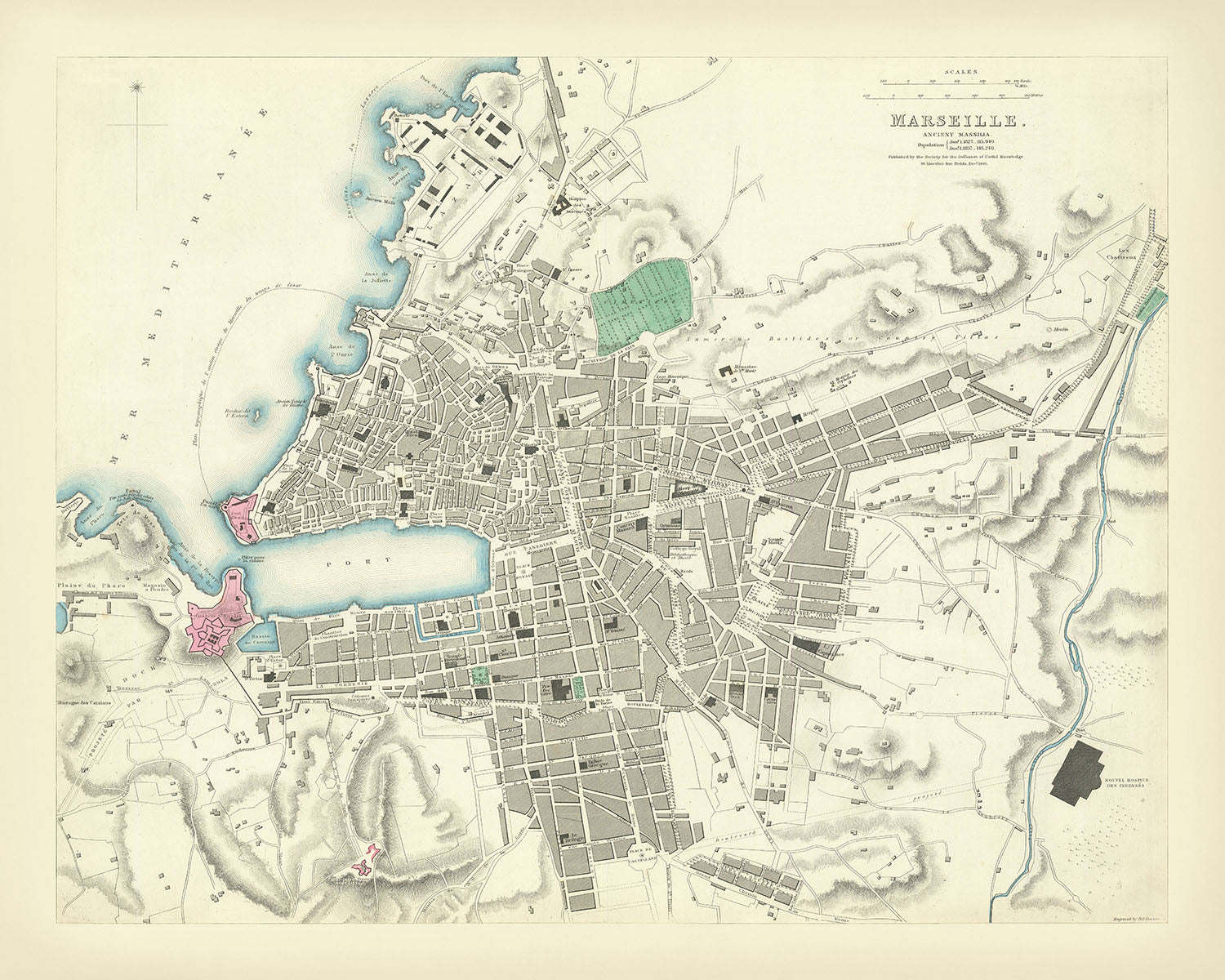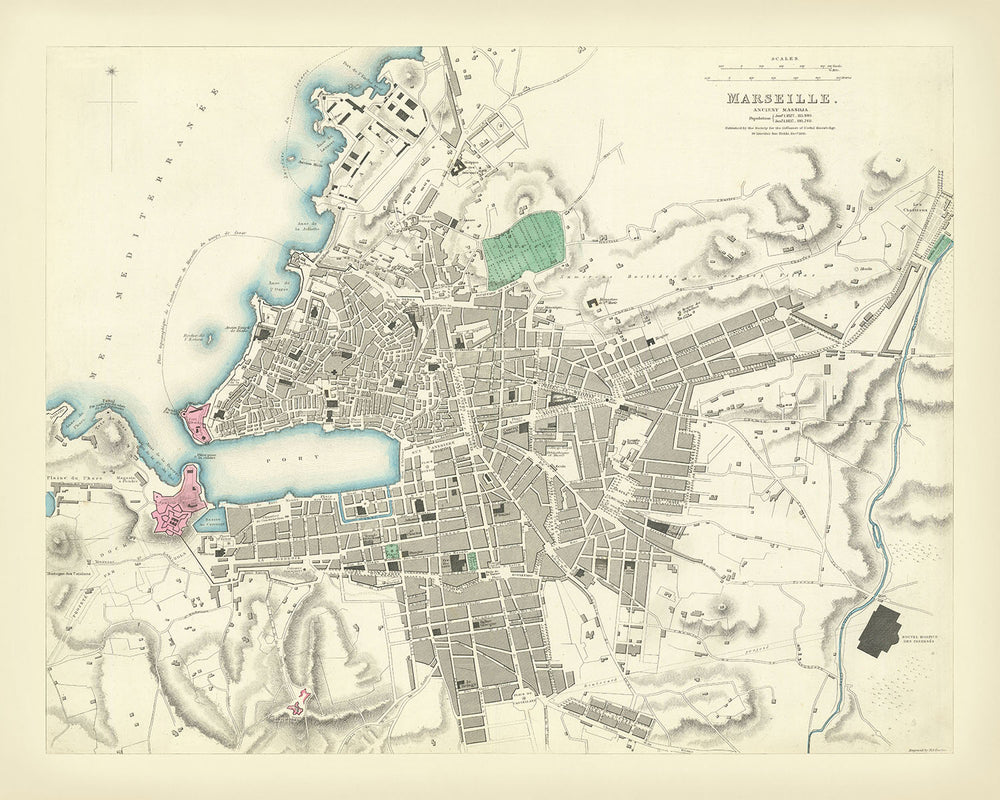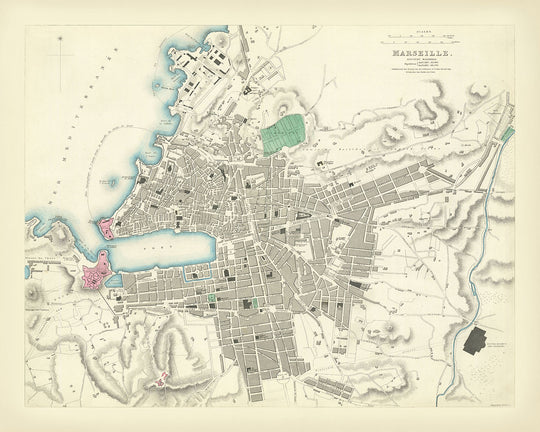- Handmade locally. No import duty or tax
- FREE worldwide delivery
- Love it or your money back (90 days)
- Questions? WhatsApp me any time
Own a piece of history
5,000+ 5 star reviews


The "Marseille" map, crafted by the esteemed Society for the Diffusion of Useful Knowledge (SDUK) in 1870, is a captivating window into the historical urban landscape of one of France's most significant port cities. This antique map is celebrated for its meticulous detail and exceptional quality, making it one of the finest representations of Marseille published in a commercial atlas during the 19th century. It vividly captures the intricate street layout, key landmarks, and topographical features, offering a fascinating glimpse into the city's past.
Marseille, a city with a rich maritime heritage, is beautifully depicted in this map, highlighting its bustling Vieux-Port (Old Port), the heart of the city's commercial and social life. The map meticulously outlines the harbor and docks, which were crucial to Marseille's status as a major Mediterranean trading hub. The detailed rendering of Fort Saint-Jean and Fort Saint-Nicolas, along with Fort d’Entrecasteaux, showcases the city's strategic military importance and its robust fortifications designed to protect against naval threats.
Significant neighborhoods such as the historic Vieux-Port area and the elegant boulevards like Boulevard de la Liberté and Rue de la République are prominently featured, illustrating the city's urban planning and architectural evolution. The map also highlights the grand Palais Longchamp, a monumental complex that symbolizes Marseille's cultural and artistic aspirations during the 19th century. This level of detail not only serves as a historical record but also as a testament to the city's vibrant and dynamic character.
The inclusion of green spaces such as Parc Borély reflects the city's commitment to public leisure and recreation, offering a serene contrast to the densely built urban areas. The map's depiction of various public squares, including Place Castellane and Place Jean Jaurès, further emphasizes the importance of communal spaces in the social fabric of Marseille. These features collectively provide a comprehensive overview of the city's infrastructure and public amenities during a period of significant growth and modernization.
The SDUK, renowned for its mission to disseminate knowledge through high-quality maps and educational materials, has produced a masterpiece with this map of Marseille. Their dedication to accuracy and detail is evident in every aspect of this map, making it an invaluable resource for historians, collectors, and enthusiasts of cartography. This map not only serves as a beautiful piece of art but also as a vital historical document that captures the essence of Marseille in the late 19th century.
Streets and roads on this map
- Allée de Meilhan
- Boulevard de la Liberté
- Boulevard Dugommier
- Boulevard du Musée
- Cours Belsunce
- Cours Bonaparte
- Cours Joseph Thierry
- Cours Saint-Louis
- Cours Saint-Maurice
- Cours Sainte-Anne
- Impasse de la Providence
- Place Castellane
- Place de l’Opéra
- Place des Capucines
- Place des Phocéens
- Place du Chapitre
- Place du Palais de Justice
- Place du Prado
- Place du Terrail
- Place Estrangin
- Place Jean Jaurès
- Place Saint-Ferréol
- Place Saint-Michel
- Place Villeneuve
- Quai de la Fraternité
- Rue de la République
- Rue de Rome
- Rue des Fabres
- Rue Saint-Ferréol
- Rue Sainte
Notable Features & Landmarks
- Fort Saint-Jean
- Fort Saint-Nicolas
- Fort d’Entrecasteaux
- Palais Longchamp
- Vieux-Port (Old Port)
- Parc Borély
- The harbor and docks
- Various fortifications and military structures
Historical and design context
- Antique Map of Marseille, France
- Highly detailed town plan of Marseille
- One of the best maps of Marseille published in a commercial atlas in the 19th Century
- Date created: 1870
- Mapmaker/Publisher: SDUK (Society for the Diffusion of Useful Knowledge)
- SDUK was a British publishing organization that produced maps and educational materials in the 19th century, aiming to provide accessible knowledge to the public.
- Detailed street layout of Marseille
- Key landmarks and buildings
- Topographical features
- Reflects the urban development and layout of Marseille in the late 19th century
- Provides historical insights into the city's infrastructure and key landmarks during this period
Please double check the images to make sure that a specific town or place is shown on this map. You can also get in touch and ask us to check the map for you.
This map looks great at every size, but I always recommend going for a larger size if you have space. That way you can easily make out all of the details.
This map looks amazing at sizes all the way up to 70in (180cm). If you are looking for a larger map, please get in touch.
Please note: the labels on this map are hard to read if you order a map that is 20in (50cm) or smaller. The map is still very attractive, but if you would like to read the map easily, please buy a larger size.
The model in the listing images is holding the 16x20in (40x50cm) version of this map.
The fifth listing image shows an example of my map personalisation service.
If you’re looking for something slightly different, check out my collection of the best old maps to see if something else catches your eye.
Please contact me to check if a certain location, landmark or feature is shown on this map.
This would make a wonderful birthday, Christmas, Father's Day, work leaving, anniversary or housewarming gift for someone from the areas covered by this map.
This map is available as a giclée print on acid free archival matte paper, or you can buy it framed. The frame is a nice, simple black frame that suits most aesthetics. Please get in touch if you'd like a different frame colour or material. My frames are glazed with super-clear museum-grade acrylic (perspex/acrylite), which is significantly less reflective than glass, safer, and will always arrive in perfect condition.
This map is also available as a float framed canvas, sometimes known as a shadow gap framed canvas or canvas floater. The map is printed on artist's cotton canvas and then stretched over a handmade box frame. We then "float" the canvas inside a wooden frame, which is available in a range of colours (black, dark brown, oak, antique gold and white). This is a wonderful way to present a map without glazing in front. See some examples of float framed canvas maps and explore the differences between my different finishes.
For something truly unique, this map is also available in "Unique 3D", our trademarked process that dramatically transforms the map so that it has a wonderful sense of depth. We combine the original map with detailed topography and elevation data, so that mountains and the terrain really "pop". For more info and examples of 3D maps, check my Unique 3D page.
For most orders, delivery time is about 3 working days. Personalised and customised products take longer, as I have to do the personalisation and send it to you for approval, which usually takes 1 or 2 days.
Please note that very large framed orders usually take longer to make and deliver.
If you need your order to arrive by a certain date, please contact me before you order so that we can find the best way of making sure you get your order in time.
I print and frame maps and artwork in 23 countries around the world. This means your order will be made locally, which cuts down on delivery time and ensures that it won't be damaged during delivery. You'll never pay customs or import duty, and we'll put less CO2 into the air.
All of my maps and art prints are well packaged and sent in a rugged tube if unframed, or surrounded by foam if framed.
I try to send out all orders within 1 or 2 days of receiving your order, though some products (like face masks, mugs and tote bags) can take longer to make.
If you select Express Delivery at checkout your order we will prioritise your order and send it out by 1-day courier (Fedex, DHL, UPS, Parcelforce).
Next Day delivery is also available in some countries (US, UK, Singapore, UAE) but please try to order early in the day so that we can get it sent out on time.
My standard frame is a gallery style black ash hardwood frame. It is simple and quite modern looking. My standard frame is around 20mm (0.8in) wide.
I use super-clear acrylic (perspex/acrylite) for the frame glass. It's lighter and safer than glass - and it looks better, as the reflectivity is lower.
Six standard frame colours are available for free (black, dark brown, dark grey, oak, white and antique gold). Custom framing and mounting/matting is available if you're looking for something else.
Most maps, art and illustrations are also available as a framed canvas. We use matte (not shiny) cotton canvas, stretch it over a sustainably sourced box wood frame, and then 'float' the piece within a wood frame. The end result is quite beautiful, and there's no glazing to get in the way.
All frames are provided "ready to hang", with either a string or brackets on the back. Very large frames will have heavy duty hanging plates and/or a mounting baton. If you have any questions, please get in touch.
See some examples of my framed maps and framed canvas maps.
Alternatively, I can also supply old maps and artwork on canvas, foam board, cotton rag and other materials.
If you want to frame your map or artwork yourself, please read my size guide first.
My maps are extremely high quality reproductions of original maps.
I source original, rare maps from libraries, auction houses and private collections around the world, restore them at my London workshop, and then use specialist giclée inks and printers to create beautiful maps that look even better than the original.
My maps are printed on acid-free archival matte (not glossy) paper that feels very high quality and almost like card. In technical terms the paper weight/thickness is 10mil/200gsm. It's perfect for framing.
I print with Epson ultrachrome giclée UV fade resistant pigment inks - some of the best inks you can find.
I can also make maps on canvas, cotton rag and other exotic materials.
Learn more about The Unique Maps Co.
Map personalisation
If you're looking for the perfect anniversary or housewarming gift, I can personalise your map to make it truly unique. For example, I can add a short message, or highlight an important location, or add your family's coat of arms.
The options are almost infinite. Please see my map personalisation page for some wonderful examples of what's possible.
To order a personalised map, select "personalise your map" before adding it to your basket.
Get in touch if you're looking for more complex customisations and personalisations.
Map ageing
I have been asked hundreds of times over the years by customers if they could buy a map that looks even older.
Well, now you can, by selecting Aged before you add a map to your basket.
All the product photos you see on this page show the map in its Original form. This is what the map looks like today.
If you select Aged, I will age your map by hand, using a special and unique process developed through years of studying old maps, talking to researchers to understand the chemistry of aging paper, and of course... lots of practice!
If you're unsure, stick to the Original colour of the map. If you want something a bit darker and older looking, go for Aged.
If you are not happy with your order for any reason, contact me and I'll get it fixed ASAP, free of charge. Please see my returns and refund policy for more information.
I am very confident you will like your restored map or art print. I have been doing this since 1984. I'm a 5-star Etsy seller. I have sold tens of thousands of maps and art prints and have over 5,000 real 5-star reviews. My work has been featured in interior design magazines, on the BBC, and on the walls of dozens of 5-star hotels.
I use a unique process to restore maps and artwork that is massively time consuming and labour intensive. Hunting down the original maps and illustrations can take months. I use state of the art and eye-wateringly expensive technology to scan and restore them. As a result, I guarantee my maps and art prints are a cut above the rest. I stand by my products and will always make sure you're 100% happy with what you receive.
Almost all of my maps and art prints look amazing at large sizes (200cm, 6.5ft+) and I can frame and deliver them to you as well, via special oversized courier. Contact me to discuss your specific needs.
Or try searching for something!















































